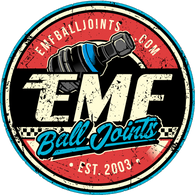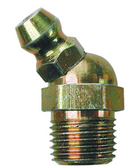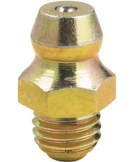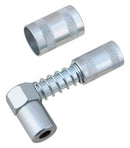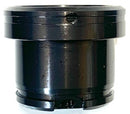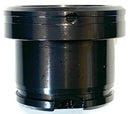- Login/signup
-
Search
Frequently Asked Questions
Check most frequently asked questions here, if you still need help then please contact us at sales@emfrodends.com
Oversized Info
If you know you haven't changed the ball joints out before, you will be just fine with the Regular Size. If you have changed them out before, but don't know which ones to order, here are a few tips.
First off... what is an Oversized Ball Joint?
It's simply a ball joint body with a large outer diameter measurement than factory made for the specific purpose of fitting in a hole that has been enlarged. It is not a heavy duty ball joint and nothing else other than the outer diameter is bigger.
The need for over sized ball joints comes only from :
1) Someone prior to you changed the ball joints and unknowingly installed over sized joints because that's what they were sold. They then struggled to press them into the axle and stretched the holes out.
2) Same as number one but a shop did it
3) Someone "usually an apprentice or DIY guy" decided to clean the hole with a flap wheel or some other abrasive and they hogged the hole out. (This is what oversized ball joints were meant to fix)
never ever
4) Someone, either a mechanic or DIY guy, pressed the ball joint in crooked with the press and just cranked it in rather than relieving it occasionally with a hammer (many mechanics seem to not like the hammer on clamp method) and chewed the side of the hole out with the ball joint body.
All reasons are because someone somewhere made a mistake. It's not because you wore the ball joints out really bad or because they've been changed a lot. However, if they have been changed a lot by someone incorrectly, then the holes can enlarge. Nothing is concrete. This is where it becomes hard to tell what you need. It's easy if the trucks never been touched.
Now for some signs of how to tell what you might need:
- The easiest is obviously taking the old ball joints out and measuring them. If they came out easy, measure inside the hole in 4 places, then divide by 4 to get the average size. In the Ball Joint Descriptions on the website, there are sizes listed so you can compare to see which ones you may need. Of course, that will require some down time. If you can afford the downtime, this is the best option... but if you can't there may be a couple ways to see without taking the truck apart.
- Take a look at the lower ball joint and see if there's a part number stamped into it. For example, if it says K7467 (Moog's number for 03-13 lowers) then you should choose the oversized. You may see another company part number stamped into it as well. You can always look up that brand and see if they have measurements that you can compare to ours.
- Not all knurled ball joints are oversized. Some are standard sized and some are oversized. It's not a good way to identify. Knurling is simply a technique used by some manufacturers to make a random outer diameter without having to maintain a precise sizing, meaning they can fib a bit here and there and it will still press into the hole easy. The knurling flattens out when installed on cheap joints. On better quality joints they dig into the knuckle.
- Oversized ball joints are a specialty item and should be marked to easily identify. They unfortunately aren't. We machine a ring around our housing to mark ours. I've noticed Moog has similar lines now. Their older ones did not. It would be nice if other companies would do the same so this wouldn't be such an issue.
Have a hole that is beyond the size of the oversized? We can custom machine one for you... we call these the "Fat Boys". For this you will need 4 measurements inside the hole of the knuckle and then divide by 4 to get the average. WE WILL NOT MAKE A CUSTOM JOINT WITHOUT PROPER MEASUREMENTS. You need to know what they are so you can get a ball joint that will fit properly. Just guessing can result in a housing being too large or too small and a waste of your time and money because they aren't returnable. Give us a call if you need a Fat Boy and we will be happy to help.
Returns
Return Policy
EMF will allow an authorized return or replacement of a product if there is a warranty issue even if you purchase from one of our Approved Dealers. If you order from EMF Online or over the phone and we make the mistake of sending the wrong part to you, please contact us directly and we will guide you through the process of the return.
All authorized returns must have an RMA number associated with it and we must receive the items back before issuing a credit or replacement. Please package items well to avoid damaging the product or the threads upon return. Shipping companies use boxes as footballs so please keep this in mind. PACKAGE WELL. Any damaged threads or parts we receive back will result in a surcharge.
You are responsible for the shipping costs of returning them and the shipping costs of sending out the new parts. Once again, we cannot stress any more - PLEASE PACKAGE WELL. Any damage that occurs during shipping due to improper packaging will result more charges to cover the replacement costs of those parts we can no longer use to resell. Please contact us first for an RMA number.
NO RETURNS ON BALL JOINT HOUSINGS, SINGLE BALL JOINTS OR CUSTOM MACHINED PRODUCTS!!!!!
EMF WILL NO LONGER ACCEPT RETURNS BECAUSE A CUSTOMER DECIDED THEY DID NOT WANT THEM ANYMORE OR THEY SOLD THEIR TRUCK BEFORE PUTTING THEM IN. WE WILL ONLY ACCEPT RETURNS IF THERE IS A WARRANTY ISSUE, DEFECTIVE MERCHANDISE OR EMF SHIPPED THE WRONG PARTS IN ERROR SEE BELOW FOR DETAILS.
RETURNING ALLEGED DEFECTIVE MERCHANDISE THAT HAS BEEN USED OR INSTALLED
Subject to the terms of our Limited Warranty, alleged defective merchandise that has been used or installed may be returned for inspection and warranty determination with these conditions:
- No returns without a copy of original invoice.
- No returns on partial or incomplete kit or used tools.
- No refunds on electrical, special order, custom made, installed parts, manuals, videos, or used tools unless truly defective.
- No returns after 30 days except for defective items.
- Returns that require cleaning or repackaging due to customer handling may, on a case-by-case basis, be charged a restock fee of up to 20%to cover the cleaning, repackaging and re-labelling of parts to resell.
- Authorization must be obtained prior to returning any merchandise. A Return Materials Authorization (RMA) number will be given to you upon approval by calling or texting 1(403)935-3540, Monday through Friday, 8am – 5pm MST or emailing us at sales@emfrodends.com. The RGA number must appear clearly on the outside of the package you are returning. All item(s) must be unused and postmarked for return within 7 calendar days after RMA is issued to customer or item(s) will cease to be eligible for credit or refund and will be refused upon receipt.
7. Please write the RMA number clearly on the outside of the package of the item(s) to be returned (NO RMA NUMBER, NO RETURN) and return fully insured and duty paid via
Canada Post / USPS to:
Returns: EMF Rod Ends & Steering Components
PO Box 619, Linden, Alberta T0M1J0
(403) 935-3540
Or if shipping by UPS, Fedex, Purolator or any other company (remember it needs to be duty paid as we are not responsible for any duties or customs fees when returning your items)
EMF Rod Ends & Steering Components
825 Central Avenue W
Linden, Alberta Canada
T0M1J0
(403) 935-3540
- Merchandise being returned must come back freight prepaid, insured, duty paid in original packaging with proper protection for the parts, and with a copy of the original invoice enclosed. If the items are not insured and the shipping company loses the package, you lose your refund.
- CUSTOMS INFO
when shipping back from the US to Canada, you need to fill the customs information out properly. Ball Joint Returns - Mark them as Return/Warranty, description is "Automotive Suspension Ball Joint", value will be whatever the value is that you are shipping back to us, harmonized code is generally 8708.80 (anything suspension parts has this harmonized code) and it is made in Alberta Canada by us. REMEMBER... IT MUST BE CUSTOMS PAID. If we have to pay any customs fees, that amount comes off your return amount.
You should expect to receive your refund within four weeks of giving your package to the return shipper, however, in many cases you will receive a refund more quickly. This time period includes the transit time for us to receive your return from the shipper (5 to 10 business days), the time it takes us to process your return once we receive it (3 to 5 business days), and the time it takes your bank to process our refund request (5 to 10 business days).
Technical Help
We came across this article from Auto Quarterly and thought it was so great that we would paste it here for everyone else to enjoy. Thank you to autoquarterly.com for providing the info (update - it seems like the page is no longer working, so we apologize for the lost images connected to this article).
Over time, the joints and components on your car loosen or wear out. When the components that hold the wheels on fall out of tolerance, it can make your car handle poorly or wear your tires out much quicker. To fix the problem, all cars have adjustable components that allow you to adjust the alignment of the wheels.
There are three main properties centered around wheel alignment: toe, camber, and caster. In this article, we’ll be looking at the toe adjustment. Toe is one of the easiest adjustments to understand; just look down at your feet. If your toes point in towards each other, that’s toe-in. If they point out away from each other, that’s toe-out.
What Is Toe?
Toe is a very simple concept, but it can be a little bit difficult to understand the effects it has on your car. To start, take a look at the following diagram. It shows toe-in, but it’s easy to imagine the reverse as well, which is toe-out.
The easiest way to understand how toe effects cars is to assume that a car wants to travel in the direction the tires face. When the two front tires point towards each other, the car wants to go straight (picture it like pushing your palms together). When they point out, your car wants to turn left or right.
Generally, you want your tires to be mostly parallel. Even more extreme setups only have differences measured in fractions of an inch. However, there are reasons you might want a little bit of toe-in or toe-out.
Toe-In vs. Toe-Out
Unlike caster and camber, which are expressed in positive or negative degrees, toe is often expressed as a simple distance measurement.
In industry terms, it’s the difference in track width as measured at the leading edge of a tire and the trailing edge of the tire. In practical terms, it’s a measurement that represents how far the wheels are turned in or away from each other.
The tires are considered to be pointed in if they angle in towards the car as the car moves forward. They are considered to be pointed out if they angle out away from the car. Sometimes, toe-in is considered positive, and toe-out is considered negative. That’s simply a way to keep all the alignment settings standardized.
How Toe Affects Driving
There are basically two ways that toe affects a car’s performance. Adjusting the toe can make your car handle better in the corners, or it can make it easier to keep the car straight on the highway.
The good news is that adjusting the toe angles is directly related to the car’s handling. That makes setting up your car fairly simple.
Toe-In for Stability
If you do primarily highway driving, or go on a lot of long road trips, you’ll want to have a little bit of toe-in. That will help keep your car going straight by resisting steering input. That has the added benefit of making longer drives more comfortable because minor road variations won’t translate to the steering wheel.
The downside is that you are sacrificing some cornering capability because your car will be resisting steering input. That’s especially noticeable at lower speeds because it lowers your steering angle.
What Is Steering Angle?
When you turn the steering wheel, there is a maximum amount of turning that can occur. That’s because there are some hard physical limitations. The steering arm only has so much room to move before, and the tires themselves only have so much space to turn back and forth.
The higher the steering angle, which is to say the more that the tires can turn, the better your car can take sharp corners at low speeds. Adjusting the wheels so that there is a little bit of toe-in reduces your steering angle. In essence, you are directly subtracting the toe-in angle from the steering angle because the wheel won’t be as turned when it hits the steering limits.
Toe-Out for Cornering
Cars are more stable and resist turning if you have a moderate amount of toe-in, so it follows that they have less turning resistance with some toe-out. Race cars and other vehicles that value performance over comfort will have some toe-out. That allows them to “snap” into a turn, and maximize turning angles.
The downside is that a car with toe-out can be a bit twitchy. When you make a car easier to steer, any minor movement of the steering wheel gets translated directly into a change in tire direction. Most people move their hands around a lot as they drive. Their hands get tired, or they need to reach for a drink, or they are shifting gears and they have to take their hands off the wheel for a second. You will feel the car move in that moment you release the wheel.
How Toe Affects Tire Wear
Excessive toe will wear down a tire more quickly than a properly aligned vehicle will. There are two ways that a tire will lose tread because of toe-in or toe-out. The first is very similar to castor issues; you’ll notice feathering.
The second is that the inside or outside of the tire will be worn down more than the opposing side, similar to what happens when you have excessive camber.
Feathering
Feathering can make a tire look like it has gills. When you look across the top of the tread, it should be even; all the tread blocks should be the same height. When a tire experiences excessive feathering, the tread will look jagged.
The biggest problem with feathering is that it can harm a tire’s ability to expel water. It’s certainly not the worst thing that can happen to a tire, but you will need to replace them sooner than a tire without feathering.
Inner or Outer Tread Wear
The inside of the tire is the side that is closest to the center of the car. If your car has excessive toe-out, the inside of the tire contacts the pavement before the rest of the tire, which causes it to wear out faster. Excessive inner-edge tread wear, especially on one side of your car but not the other, is a sure sign you need an alignment.
Toe-in has less effect on tread wear, although it may cause some outer-edge tread wear. It can be difficult to tell what issue you are having if you have some outer-edge tread wear since almost every alignment or tire issue causes the outside of a tire to wear down faster.
When to Adjust Toe
Your car’s service schedule will tell you when to check your alignment and what your factory toe angle is. Often, a commuter car will come from the factory with some toe-in. Most cars, however, will have a very neutral toe angle.
You may want to adjust your toe angle to a non-factory angle in order to bring out certain driving characteristics. Toe angle is adjusted in very small increments, so we encourage you to experiment with it a little. Add in some toe-in if you do a lot of highway driving, or give yourself a little toe-out for better handling. You might find you enjoy it a lot more than the factory settings.
Point Your Toes in the Direction of Stability
Keeping your car’s wheels aligned is an important part of the driving experience. Bad alignment is bad for your wallet, and it can detract from the enjoyment of keeping your car on the road. Don’t suffer from poor handling. Get the toe adjusted to suit your needs and enjoy those road miles.
I just installed EMF Ball Joints and my Knuckle is Stiff
Unbolt the knuckle and inspect the holes. Chances are, the Lower one is damaged. If the lower hole looks fine, it is possibly the upper.
This is a very common Dodge Issue, seen mostly in trucks made from 2005.5 to 2007.5. It still happens In other years but we see the problems more in these years. 2014 and up Dodge, we found it is common in Service Trucks, Welding Trucks or any trucks used for heavy use.
Quick Diagnosis - take the set screw out of the Upper Ball Joint, Undo the Cap using a spanner wrench (if the cap won’t come loose, it's probably because the set screw is knurled and sometimes creates a burr on the threads. Try moving the cap back and forth with the spanner wrench until you break through the burr) Once the cap is loosened, the knuckle won’t completely free up - but you should notice a difference. This is a definite sign of the upper knuckle hole being misaligned.
Quick Steps to try and relieve it - Did you power the Ball Joint all the way in with the Ball Joint Press? If so, the Upper Ball joint may not be installed straight. By powering it in and not using a hammer to help impact, the joint isn’t relieved as it goes in. Once you ensure the Ball Joint is in all the way and straight, you can eliminate this as an issue. The shoulder of the ball joint should sit flush with the knuckle all the way around with no gaps.
A solution is to replace the spindle knuckle, however, we found that brand new OEM knuckles can still be misaligned and expensive. We have made a Pin and Insert for the Upper Ball Joint to help relieve the pressure put on the lower ball joint due to the upper ball joint misalignment. It is a separate pin and race and unfortunately we can’t predict who’s truck has defective knuckles so we don’t supply these pins, you can purchase them separately. In extreme cases, these pins may not help and it is recommended to replace the spindle knuckle.
Hopefully the crappy QC of the Spindle Knuckle Manufacturer misses you and you receive a good knuckle And don’t have to endure any of these problems In the future.
If you need to purchase a Stiff Pin Kit, go here: 2003+ Dodge Upper Ball Joint Stiff Pin Set | EMF Ball Joints
STIFF KNUCKLE VIDEO INFO STARTS AT 22:36 IF YOU WANT TO SKIP AHEAD TO IT.
My truck feels like it's "All Over the Place". What could it be?
- Did you recently install a new Steering Box, or decide to tighten your existing steering box? We have seen an extremely large number of issues deriving from the steering box. Yes, this also applies to brand new ones!! They are coming from the factory over tight, or you are over tightening it - leading to a looser feeling in the steering. See our video on this topic here:
- After installing Ball Joints - Did you get an alignment? is it extremely important to get an alignment! As your existing ball joints and other components wear, it will change the angle your tires sit at. You also may not have put your tie rod ends in the exact same place it was before or changed to new tie rod ends, or have old worn out tie rod ends... so that will also change the way your truck drives.
- After installing Ball Joints - Did you rotate your tires? It is also extremely important to rotate the tires as well as get an alignment! The worn ball joints will create wear patterns in the tires and when new ball joints are installed, your tires will not sit in the same spot they used to be.
- EMF Ball Joints make a vehicle more responsive. It's easier to turn and move because we don't over-tighten the joints and pack them full of plastic to mask that feeling. Sometimes a feeling of your truck being "All over the place" could simply be because you're not used to the responsiveness. If you really don't like it being that responsive, you can start by tightening the lower ball joint. You can do this on the truck, but it does require effort. (keep in mind that if you over-tighten it, it could result in memory steer where you turn in one direction and it keeps going that direction so try with small amounts of tightening first to see how you like it) Here is a video explaining the process on how to tighten the lower ball joint ring without removing the ball joint from the truck:
- Another reason why your truck could feel like it's all over the place is if you have a worn bushing in the Intermediate Shaft. For older vehicles under 2003 you have a Rag Joint under the hood on the driver side near the brake booster. When that bushing wears out, it can cause the steering wander. For 2003+ trucks, we include the intermediate shaft bushings with the ball joint kits. They look like 2 little aluminum washers and you can tap them in the shaft in about 5 minutes using a hammer. More info on the steering shaft bushings is here: https://emfballjoints.com/collections/dodge-ram-intermediate-steering-shaft-fix/products/dodge-ram-2500-3500-intermediate-shaft-bushing
- Do you have a steering box brace? It could also be the culprit. Video below showing problems with braces,
Glad you asked! It can be many things, but here some interesting findings that we recently discovered while trying to figure out whats inside the steering box.
MOST COMMON ISSUES FOR TROUBLESHOOTING DRIVABILITY
CHECK OUT OUR YOUTUBE CHANNEL FOR VIDEOS ON THESE TOPICS! https://www.youtube.com/@EMFEVO
1. MEMORY STEER – WHEN YOU POINT THE WHEEL ONE WAY AND THE VEHICLE KEEPS GOING THAT WAY. IF YOU HAVE MEMORY STEER, THE VEHICLE WILL DRIVE STRAIGHT AS AN ARROW. IT WILL NOT WANDER, IT WILL NOT DART.
2. WANDERING – VEHICLE DRIVES LEFT OR RIGHT WHILE WHEEL IS BEING HELD STRAIGHT.
3. DARTINESS – THIS IS THE MOST COMMON PROBLEM. IT IS WHEN YOU CONSTANTLY HAVE TO CHASE THE VEHICLE DOWN THE ROAD. IT FEELS LIKE THE TRUCK IS ALL OVER THE PLACE.
1. MEMORY STEER
· TIGHT KNUCKLES – DID YOU CHECK THE KNUCKLE AFTER INSTALL TO MAKE SURE IT MOVED SIDE TO SIDE FREELY?
· WHAT IS A TIGHT KNUCKLE? POOR MACHINING FROM THE KNUCKLE MANUFACTURER RESULTING IN HOLES THAT ARE MISALIGNED.
· ON DANA 60 BALL JOINTS (FORD SUPERDUTY & 94-99 RAM 2500/3500) AN IMPROPERLY INSTALLED CASTER/CAMBER SLEEVE CAN INSTANTLY CAUSE MEMORY STEER AND EXTREMELY TIGHT KNUCKLES.
· DID YOU JUST REPLACE YOUR TIE ROD ENDS WITH NEW ONES? STIFF TIE ROD ENDS CAN CAUSE MEMORY STEER.
· IMPROPERLY INSTALLED STEERING BOX BRACES
· STEERING BOX BRACE BEARINGS THAT ARE SEIZED
· NEVER GREASING THE BALL JOINTS
· DAMAGED STEERING STABILIZER
· AN OVER-TIGHT STEERING BOX
· A STEERING DAMPENER THAT IS OVER-VALVED, HAS TOO THICK OF OIL OR IS IN EXTREME COLD – THE OIL IS TOO STIFF AND CAN CAUSE MEMORY STEER.
2. WANDERING
· BAD OR WORN TIRES, CHEAP TIRES
· LOOSE OR WORN TRACK BAR BUSHING
· LOOSE TRACK BAR BOLT
· WORN DRAGLINK ENDS
· WORN INTERMEDIATE STEERING SHAFT BUSHING
· LOOSE STEERING BOX SECTOR SHAFT NUT (COMMON WITH BOX BRACES)
· VERY SELDOMLY WANDERING IS CAUSED BY A LOOSE STEERING BOX! MANY PEOPLE MISDIAGNOSE A LOOSE STEERING BOX, THEY OVERTIGHTEN IT AND CREATE MORE ISSUES WHICH WILL FEEL LIKE THE WANDER HAS INCREASED. (THEY JUST CREATED DARTINESS). CHECK OUT OUR YOUTUBE VIDEOS ON THIS TOPIC!
3. DARTINESS
· ALIGNMENT - NOT ENOUGH OR TOO MUCH TOE
· ALIGNMENT – NOT ENOUGH CASTER
· STEERING BOX – TOO TIGHT OF LASH (CAN HAPPEN EVEN IN BRAND NEW BOXES!) CHECK OUT OUR VIDEOS ON YOUTUBE ON THIS TOPIC!
· IF THE TRUCK ISN’T RETURNING COMPLETELY TO CENTER AND DARTS LEFT AND DARTS RIGHT – IT IS NOT MEMORY, IT IS TIGHT BOX LASH.
4. RETURN TO CENTER ISSUES (WHEEL ALMOST COMES BACK TO CENTER BUT NOT QUITE)
· TIGHT STEERING BOX LASH (ONCE AGAIN, CHECK OUT OUR YOUTUBE VIDEOS ON THIS TOPIC!)
Why we don’t like box braces. There are so many reasons but I’ll try to narrow it to a few.
- The mounting of the boxes is not straight forward. Why not? Each box mounts to the frame in a slightly different position. The holes in the frame and the mounting bolts aren’t size on size. This allows for machining errors. It also allows for the box to be slightly higher or lower or at a slightly different angle. This causes interference with the sector shaft and the support bearing which creates a problem with the lash in the box on the gears. This leads to memory and dead spots. Sporadic steering, wander. You name it and the customer always blames the box for being crap or the ball joints.
-the nut that is supplied with the box braces. It’s machined with a shaft on the end to slide into the bearing. It’s impossible to machine something linear to something that is threaded. Unless its on the thread when its machined. This means the shaft doesn’t move perfectly on centre , which it needs to. It misaligns the shaft movement. That, in turn, pushes the shaft against the side of the bearing. Once again doing things like putting pressure on the gears in the steering box. It also leads to really stiff steering as the bearing wears. And you guessed it the customer will blame the box and the ball joints. The best part is someone will adjust the box thinking its loose (because they see the input shaft moving and not the sector shaft but they don’t know the bearing is binding and the torsion rod in the solenoid valve is just flexing)
-when people adjust the box lash, if the bearing is left on the box, it prevents the shaft from moving in or out. Which puts pressure on the adjustment screw and you guessed it they’ll blame the box for being worn out.
-the brace manufacturers don’t hold good tolerances. It’s pretty hard to stay within a few thousands of an inch when breaking and welding plate. It wouldn’t matter even if they could because as I said earlier every box mounts a little different. It can be compensated for with spacers at the bearing but not many people notice when the mount, the bearing and the sector shaft aren’t the right separation. Leading to force being put on the sector shaft.
-The mounting nut doesn’t allow for an easy torque check and hides loose pitman to sector shaft fits. It may be great when it leaves the shop but 3 months down a lot of gravel roads and those nuts back off allowing slop in the splines. Everything looks good but the arm is sandwiched against the sector shaft with the bearing and the mount not the nut. It leads to wander and death wobble. It also leads to the box being diagnosed as the issue by many people. Again, many times because the box gets tightened trying to solve the issue, the box gets over tightened and that leads to people thinking the box is loose.
I’m going to stop there. If you’d like I can keep going. I will say the brace should never change how the truck steers. Ever. It’s merely a shaft support. If the truck steers straighter its because the brace was mounted incorrectly and its binding against the box. Creating memory. Memory is great for going straight or in circles. However, more people bitch and whine about no return to centre.
Box braces, if mounted correctly and are maintained properly and the customer understands everything about them, can be beneficial, for anything that takes a beating off road. If it’s a customer that drives on the street tell him like my dad used to tell me “ quit dry steering idiot, you’re going to ruin the truck”
Warranty Info
EMF Ball Joint Warranty
- Life-Time Warranty against Material and Manufacturers Defects. EMF will replace part of or the entire unit if it is determined to be an issue that falls under this category. The customer is encouraged to contact EMF directly to determine cause of fault and to receive warrantied products.
- Warranty does not cover breakage due to misuse of the product, improper installation or as a result of another component failure on the vehicle.
- EMF Ball Joints are meant to be rebuilt, which means the internal races and pin will wear over time under normal circumstances. The internal race and pin components are not covered by replacement Warranty, unless it is determined there is a manufacturer defect that caused premature wear. In order to maximize your product life, regular maintenance and greasing are required.

